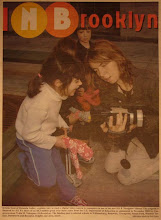 My friend and colleague Heather Oakley's dream has come true: Global Gardens, an educational garden project for children in Tulsa, OK, is up and running! Through her garden workshops at Eugene Field Elementary School, Heather has combined her love for children from all over the world with her care for the earth, infusing her work with characteristic joy, hope and wisdom. The creation of a community garden with 31 student, family, and teacher garden plots (each with a theme, from "Oklahoma" to "Literary" to "Berry" Garden!) is providing a wonderful forum for members of the school and local community to learn about each other and the earth in a cross-disciplinary way, with science and peace education constantly interacting and informing one another. Heather's amazing method of gardening and teaching reveals to students and friends that physical, tangible growth is a vibrant manifestation of the growth of the soul. She is offering to the children a bridge from inside to outside, a solid link between their learning and their real lives. The centrality of documentation and blogging to the project provides yet another bridge--from the Eugene Field and Tulsa communities, to the world around them. I am looking forward to inviting children in NYC to dialogue with the Global Gardeners...
My friend and colleague Heather Oakley's dream has come true: Global Gardens, an educational garden project for children in Tulsa, OK, is up and running! Through her garden workshops at Eugene Field Elementary School, Heather has combined her love for children from all over the world with her care for the earth, infusing her work with characteristic joy, hope and wisdom. The creation of a community garden with 31 student, family, and teacher garden plots (each with a theme, from "Oklahoma" to "Literary" to "Berry" Garden!) is providing a wonderful forum for members of the school and local community to learn about each other and the earth in a cross-disciplinary way, with science and peace education constantly interacting and informing one another. Heather's amazing method of gardening and teaching reveals to students and friends that physical, tangible growth is a vibrant manifestation of the growth of the soul. She is offering to the children a bridge from inside to outside, a solid link between their learning and their real lives. The centrality of documentation and blogging to the project provides yet another bridge--from the Eugene Field and Tulsa communities, to the world around them. I am looking forward to inviting children in NYC to dialogue with the Global Gardeners...Global Gardens is a nonprofit, educational organization that provides schools and neighborhoods the resources that they need to incorporate educational, multi-disciplinary, science-based gardens into their curriculum and community. Global Gardens' primary goal is to establish student-centered garden spaces, where students and their families have ownership of the implementation, progress, maintenance, and activities of the garden. Global Gardens believes that these experiences encourage personal growth and lead to individuals becoming empowered to live healthier lives and become agents of change in their communities.





